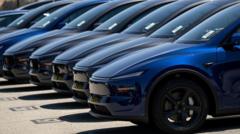Why Did Tesla Deliveries Drop 14% This Quarter?

Understanding Tesla's Recent Delivery Decline: Challenges, Competition, and Opportunities
Tesla, the pioneering electric vehicle (EV) manufacturer founded by Elon Musk, recently reported a 14% decline in vehicle deliveries for the second quarter of the year. With just over 384,000 vehicles delivered between April and June, this marks the second consecutive quarterly drop for the company. As competition intensifies, particularly from rivals like China's BYD, Tesla faces a myriad of challenges that have implications for its market position and future growth. This article delves deep into the factors contributing to Tesla's decline, the competitive landscape, and the company's strategies moving forward.
The Decline in Deliveries: An Overview
In Q2, Tesla's delivery figures fell significantly, raising concerns among investors and analysts alike. It's crucial to analyze the reasons behind this downturn, as understanding these factors can shed light on the overall health of the company and the EV market.
Key Factors Contributing to the Decline
Several factors have contributed to Tesla's declining vehicle deliveries:
- Increased Competition: The EV market is witnessing a surge in competition, particularly from established automakers and new entrants. Companies like BYD are rapidly expanding their offerings, providing consumers with more choices.
- Economic Uncertainty: Fluctuations in the global economy, including inflation and supply chain disruptions, have led to reduced consumer spending and hesitancy in making large purchases like electric vehicles.
- Government Policies: Changes in government incentives and subsidies can impact consumer purchasing behavior. The uncertainty surrounding the US EV tax credit may have deterred potential buyers.
- Production Challenges: Tesla has experienced production hiccups, including supply chain issues and manufacturing constraints that can affect delivery timelines.
Rivalry in the EV Market
The electric vehicle market is becoming increasingly crowded. As more manufacturers enter the space, Tesla's once-dominant position is facing challenges. Here are some notable competitors:
1. BYD
BYD, a Chinese automaker, has emerged as a formidable competitor in the global EV market. Known for its aggressive expansion and diverse vehicle lineup, BYD offers electric cars, buses, and trucks, making it a versatile player.
2. Legacy Automakers
Traditional automakers like Ford and General Motors are ramping up their EV offerings. With significant investments in electric vehicle technology, they are attempting to capture market share previously held by Tesla.
3. Startups and New Entrants
Numerous startups are entering the EV market, each offering unique features and price points. Companies like Rivian and Lucid Motors are targeting specific consumer segments, adding to the competition.
Impact of Government Policies
Government policies can significantly influence the electric vehicle market. The recent discussions around subsidies and incentives have raised questions about the future of EV sales.
Subsidy Changes and Their Effects
Elon Musk's controversial role as a government efficiency czar under the Trump administration has sparked discussions around subsidies for electric vehicles. With the potential removal of incentives to buy EVs, many consumers may delay their purchases.
The EV Tax Credit Uncertainty
The uncertainty surrounding the US EV tax credit has left many potential buyers in limbo. As they wait for clarity on government incentives, the hesitation to purchase new vehicles may contribute to the observed decline in Tesla's deliveries.
Investor Insights and Projections
Despite the decline in deliveries, some analysts remain optimistic about Tesla's future. According to Gene Munster of Deepwater Asset Management, the current delivery figures may mark the bottom of the downturn, with expectations of a gradual recovery.
Factors Influencing Future Deliveries
Several key factors could influence Tesla's delivery numbers moving forward:
- Tax Credit Expiration: As the expiration date for the EV tax credit looms, consumers may rush to purchase vehicles, boosting Tesla's sales in the short term.
- Product Developments: Innovations in autonomy and delivery capabilities, such as the company's push into robotaxis, could increase consumer interest and sales.
- Market Adaptation: Tesla's ability to adapt to changing market conditions and consumer preferences will be critical in regaining momentum.
Exploring Tesla's Robotaxi Initiative
One of Tesla's most ambitious projects is its robotaxi initiative, which aims to leverage autonomous driving technology to create a fleet of self-driving taxis. This innovative approach could redefine the transportation landscape.
Potential Benefits of the Robotaxi Initiative
As Tesla rolls out its robotaxi program, several potential benefits could arise:
- Increased Revenue Streams: A successful robotaxi fleet could provide Tesla with a new source of revenue, diversifying its income beyond vehicle sales.
- Enhanced Market Presence: By entering the mobility-as-a-service space, Tesla could strengthen its position as a leader in transportation innovation.
- Consumer Adoption: Offering an autonomous ride-hailing service may attract consumers who are hesitant to purchase their own vehicles.
Conclusion: Navigating Uncertain Waters
Tesla's recent decline in vehicle deliveries serves as a stark reminder of the challenges facing the electric vehicle market. With increasing competition, shifting government policies, and economic uncertainty, the company must navigate a complex landscape to regain its momentum. However, optimists like Gene Munster believe that the current downturn may only be temporary, and that Tesla can rebound if it adapts to changing consumer needs and leverages its innovative technologies. As Tesla continues to push boundaries with initiatives like robotaxis, the question remains: Can Tesla maintain its leadership in the rapidly evolving EV market?
FAQs
What are the main reasons for Tesla's decline in vehicle deliveries?
The decline in Tesla's vehicle deliveries can be attributed to increased competition, economic uncertainty, changes in government policies, and production challenges.
How is competition affecting Tesla's market share?
As more automakers enter the EV market, Tesla's dominance is challenged. Companies like BYD and various startups are offering diverse vehicle options, impacting Tesla's sales.
What role do government policies play in Tesla's sales performance?
Government policies, particularly regarding subsidies and incentives for electric vehicle purchases, significantly influence consumer behavior and purchasing decisions.
What is Tesla's robotaxi initiative?
Tesla's robotaxi initiative aims to create a fleet of autonomous self-driving taxis, potentially generating new revenue streams and redefining the transportation landscape.
As we look to the future, the evolution of Tesla's strategies will be crucial in determining its place in the automotive world. Will Tesla innovate and adapt quickly enough to stay ahead, or will it struggle under the weight of competition and changing market dynamics? #Tesla #ElectricVehicles #ElonMusk
Published: 2025-07-02 14:32:04 | Category: technology



